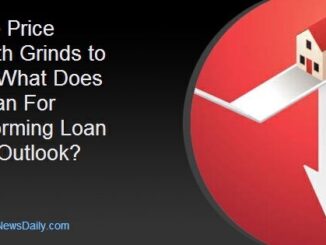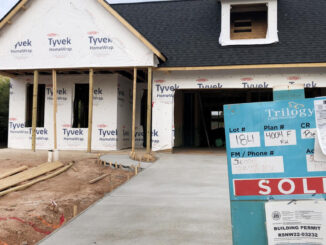
The weekly volume of new listings is now higher than at anytime last year. It’s still April, so there could be as many as eight more weeks of seller growth in the spring housing market. And seller growth is happening pretty much everywhere across the country, with Florida and Texas leading the way.
There’s two ways to interpret these trends. The bearish take is that there are many more sellers than buyers and inventory is rising. Mortgage rates are at 7.5% and there are no signs of improvement anytime soon. This implies that home prices will decline in the near future.
The more optimistic take is that more sellers will result in more sales. Even if the imbalance of more sellers than buyers continues, more sales will happen, especially compared to last year at this time.
But maybe both of these interpretations prove true. In addition to a higher number of new listings, there were also more new contracts started this week than in any week in 2023. That’s not saying much, since last year had so few home sales, but it is a step in the right direction.
orate further? Mortgage rates are now topping 7.5%, the highest levels seen this year. You’d think the sales rate would be slowing, but there aren’t signs of it. It’s possible that sales will slow, but maybe it takes a few more weeks to manifest than expected.
At Altos Research, where we track every home for sale in the country each week, the data so often defies expectations or changes very quickly. By tracking the pricing, supply and demand, sales and changes in the data, you can immediately understand it as it happens. Let’s look at the details of the U.S. housing market at the end of April 2024.
Housing inventory
There are now 556,000 single-family homes on the market. That’s up 2.4% from last week, with slightly more than 13,000 additional properties on the market now than a week ago.
Unsold inventory now is almost 32% higher than at this time last year — and it’s 90% higher compared to the end of April 2022. Two years ago, inventory was jumping along with mortgage rates. But that’s not what’s occurring now as the increases are more steady.
This is one way to illustrate that consumers are more sensitive to changes in rates than to the actual levels. Rates are higher now, so unsold inventory is higher. But two years ago, rates were climbing by 20 basis points or so each week for much of the spring. Rates were climbing rapidly and so was inventory. Now the increase in both of these lines is slower.
In 2022, there were record-low numbers of unsold homes on the market, but the numbers were climbing rapidly, with 18,000 to 20,000 properties added each week. Today, we’re adding 13,000 per week. While interest rates and inventory are rising in 2024, they were doing so much more quickly two years ago. The change in rates is what drives change in behavior.
New listings
There were 72,000 new single-family listings unsold this week, Another 21,000 homes were newly listed and already under contract (what are known as immediate sales) for a total of 93,000 new sellers this week. That’s much more than at any point of 2023. You have to go back to July 2022 to find this much seller activity in a given week.
So, why is the seller volume increasing, where is it coming from and is it time to panic?
First, keep in mind that immediate sales are still at a reasonably healthy level. Plenty of homes are receiving offers and going into contract immediately upon being listed — 21,000 this week, or 22.5% of the market.
Next, keep in mind that there are still 20% fewer sellers each week than there would have been in a “normal” year prior to the COVID-19 pandemic. There are not a lot of sellers. It’s just that in the past decade as mortgage rates fell, more real estate began to be hoarded and fewer sales took place. In the accompanying video, you can see the relative levels of new weekly listings. Seller volume is still running pretty low because homeowners have such a good deal with their low mortgage rates that they don’t want to sell.
Fixed mortgage rates mean fixed costs for most homeowners. Fixed costs theoretically means they won’t ever have to sell. But in areas where costs are rising — due to higher property taxes, insurance hikes or other rising maintenance expenses — homes are more likely to hit the resale market.
Right now, this is most obvious in Texas and Florida. Over the past year, 40% of the inventory increase at the national level has come from these two states. Texas and Florida combine for 29% of the country’s active listings and 16% of its population, so outsized gains are happening in these place. For example, if you have a second home in southwest Florida that you only use occasionally and your insurance costs tripled this year, it’s very tempting to sell. And some people are doing so.
The opposite trend is happening in New York, which has the fewest available homes per capita right now. That dubious distinction is usually reserved for California. New York has slightly fewer homes on the market than at this time last year, whereas Florida now has 59% more.
The takeaway here is that inventory gains are happening pretty much everywhere but at a significantly higher rate in the Sun Belt states — from Florida to Texas and Arizona.
Pending sales
There are 398,000 single-family homes under contract now — a few percentage points more on a year-over-year basis. These homes in the pending-sales stage will mostly close in May.
This is slight seller growth but not a pullback, even with April’s mortgage rate increases.
Frankly, this pace could’ve been expected to reverse, but it hasn’t happened yet. In 2022, sales dwindled in the second half of the year and have yet to recover. The video above illustrates how quickly home sales slowed as mortgage rates rose — especially in June and September 2022.
This year, the trajectory is staying surprisingly positive. As the average rate jumped from 7% to 7.5%, that slowdown could’ve been expected to happen again. If the market gets lucky and rates don’t climb past 8%, then the sales rate might continue to slowly recover by later this summer. But rates could keep climbing. The macroeconomic data keeps coming in strong and we’ll just have to watch to see what happens.
There were 76,000 new contracts started this week for single-family homes in the U.S. That’s more than in any week for all of 2023. It’s strong growth — 9% more than the same week a year ago. Sales volume typically peaks at the end of June, so we likely have more growth to come in the spring market. And the weekly new pending sales count is already ahead of the best weeks posted last year.
Home prices
The median price of homes under contract is now slightly more than $399,900, good for 5% year-over-year growth. What’s being tracked here is the final asking price for the homes that went into contract. This is the earliest proxy for the final sales price. Any given home may sell for more or less than asking price, but in aggregate, the actual sales price is very close to this pending sales price.
Altos Data watches several measurements of home prices. There’s asking prices, or what you’ll see if you’re shopping the market today. The median price of all homes on the market right now is just under $445,000 and is only 1% higher than in April 2023.
The price for a new listing is the best leading indicator, and there are the prices of the set that is being purchased, which is what we’re looking at here. These are all useful indicators of home prices.
Historic data shows, for example, precisely when home prices fell in June and September 2022. At that time, there were large jumps in seller inventory coupled with sudden, additional spikes in mortgage rates. So, homebuyers adjusted their expectations and prices dropped. We’re on the alert for these price declines today but have yet to see them.
Price reductions
While watching for leading indicators for changes in sales prices, we saw a meaningful uptick in price reductions. This week, 32.5% of the homes on the market included a price cut. That’s up 50 basis points from last week and is 340 bps more than at the end of April 2023.
This week last year was the final decline of the spring season. Pricing was much firmer last year, but the share of homes with price cuts in 2024 have increased for 10 weeks. It’s a much slower season compared to last year and spring is when the most upward pressure on home prices typically happens.
But price cuts are on the rise. The curve this year is following a very clear seasonal trend. Home prices are not crashing and there’s no signal anywhere in the data that a crash is imminent. But there are more homes with price cuts now than in April of any recent year, so that’s a pretty weak signal.
In the price reductions chart of the accompanying video, notice how this year’s curve is elevated above that of any recent year. There are more homes on the market with price cuts today than in any April in more than a decade — even though this rate is not climbing nearly as quickly as it did two years ago when the market changed.
If you look at the local data, you’ll see that the Florida markets are dominating in terms of price cuts. More than 50% of the homes on the market in most of the major Florida metro areas have had price cuts. Inventory is up and prices are lower on an annualized basis. Nationally, however, the data is balanced out by many markets, such as those in the Northeast, where inventory is still very low.
If mortgage rates keep climbing, we could more than 40% of U.S. listings with price cuts by the latter portion of summer. That would likely be a negative indicator for future sales prices — i.e., home price declines. As mentioned earlier, home prices today are higher than they were a year ago (by 1% to 5%, depending on which measurement is used). But the price-reductions trend seems like it is poised to slow down. It looks as if home prices in 2024 will remain flat, at best, although 2023 offered a surprise and that could happen again as this year unfolds.



